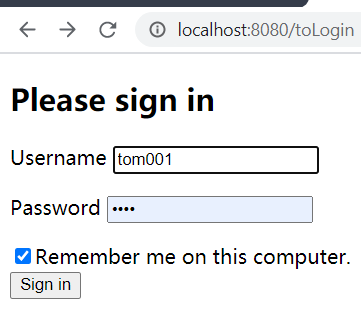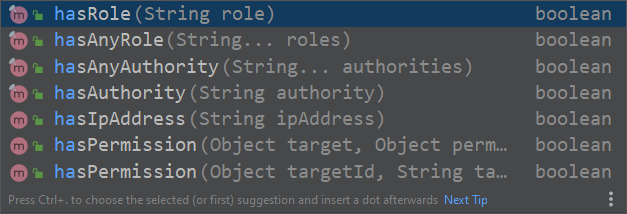SpringBoot--- SpringSecurity進行注銷權限控制的配置方法
環境
IDEA :2020.1
Maven:3.5.6
SpringBoot: 2.0.9 (與此前整合的版本2.3.3 不同,版本適配問題,為配合使用降級)
1、注銷
這里也有一個前提問題需要注意,我們登錄操作都是在開啟防跨域攻擊的環境下進行的。
毫無疑問,注銷也是在這樣的情況下進行的。
登錄時我們提交表單,采用 POST 方法傳輸,通過使用 Thymeleaf 在 form 表單添加 th:action 元素,Thymeleaf 會自動為我們添加 _csrf 元素。
同樣注銷操作也是要帶有 _csrf 參數認證的。
<form th:action='@{/logout}' method='post'><button type='submit' >注銷</button></form>
我們把它做成一個表單按鈕,同時采用 POST 方法傳輸,使用 SpringSecurity 提供的默認 /logout 方法進行登出注銷。
開發者是不需要在 Controller 配置這個 /logout 方法處理的,和 /login 一樣,這是由 SpringSecurity 提供的。
我們需要在之前登陸的配置類配置登出的各種屬性即可。
.and() //這里采用鏈式編程 .logout() .logoutSuccessUrl('/index') //注銷成功后,調轉的頁面 /* .logoutUrl() 配置自己的注銷URL,默認為 /logout .invalidateHttpSession() 是否銷毀session,默認ture .deleteCookies() 刪除指定的cookies
銷毀session 相信很容易理解,一次對話,可以注銷關閉,或者關閉頁面會自動銷毀。
記住我
cookies 需要重點介紹一下,這也是我們常用的記住我,在關閉頁面或瀏覽器之后,下次打開頁面時,是以之前登錄的用戶登錄的。
為此,我們需要在登錄表單增加記住我選項
tr><td><input type='checkbox' name='remember-me'></td><td>Remember me on this computer.</td></tr>
同時在配置類開啟記住我。
.and() .rememberMe();
這里 checkbox 的 name 我們使用默認的 remember-me ,同樣這一 cookies 的 name 也會被瀏覽器記住,這樣我們只需要開啟記住我即可使用。
如果不使用 name= 'remember-me' ,而是使用其他 name 屬性值,則需要配置指定,以便 SpringSecurity 接收是否記住我。
.and() .rememberMe().rememberMeParameter('rememberme'); //接收前端自定義記住我的name<input name='rememberme'>,默認是remember-me
回到 deleteCookies() 方法的配置上,要銷毀指定的 cookies ,我們要指定cookies 的名字即可。
.and() .logout().logoutSuccessUrl('/index').deleteCookies('remember-me') //銷毀 name='remember-me'的 cookies
瀏覽器登錄,選用記住我

登錄后, F12,查看 cookies

第一個為 cookies,第二個則是此次會話的 session 對象。
可以看到 cookies 是有限期的,默認為 14 天。
點擊注銷。

由于配置了刪除 cookies,cookies 已經被刪除。
重新登錄,這次沒有選記住我,同時 session 也已經不是同一個,值已經改變了。

2、權限控制
同時,頁面還有一個重要的需求沒有實現。
沒有某一權限的用戶,不應該看到點擊的入口(武功秘籍)。所謂得不到的最想要,你這不是擺著饞他嘛!可不能把他害咯。
對此,我們可以結合 Thymeleaf 和 SpringSecurity 實現哪些用戶可以看到哪些內容。
首先,我們要導入 thymeleaf-springsecurity 整合的依賴
<!-- thymeleaf-springsecurity整合--><!-- https://mvnrepository.com/artifact/org.thymeleaf.extras/thymeleaf-extras-springsecurity4 --> <dependency> <groupId>org.thymeleaf.extras</groupId> <artifactId>thymeleaf-extras-springsecurity4</artifactId> <version>3.0.4.RELEASE</version> </dependency>
同時還要在頁面標簽導入命名空間
<html xmlns:th='http://www.thymeleaf.org' xmlns:sec='https://www.thymeleaf.org/thymeleaf-extras-springsecurity4'>
在頁面下把需要權限限制的內容包起來
<div sec:authorize='!isAuthenticated()'><h2 >游客您好,如果想查看武林秘籍<a th:href='http://www.aoyou183.cn/bcjs/@{/toLogin}'>請登錄</a> </h2></div>
sec:authorize='!isAuthenticated()' 表示未登錄認證的用戶才可以查看到的內容。
<div sec:authorize='isAuthenticated()'><a>Count: <span sec:authentication='name'></span></a><form th:action='@{/logout}' method='post'><!--只能通過表單加 -csrf 認證,其他(超鏈接)無法添加--><button type='submit' >注銷</button></form></div>
sec:authorize='isAuthenticated()' 表示已經登錄認證的用戶才可以查看到的內容。
sec:authentication='name' 表示獲取認證的用戶的用戶名。
唉,別忘了,重點,有些武功秘籍不能讓沒有權限的用戶看到,比如 level2 的,像什么太極拳,七傷拳,梯云縱。哈哈哈
<div sec:authorize='hasRole(’level2’)'><h3>高級武功秘籍</h3><ul><li><a th:href='http://www.aoyou183.cn/bcjs/@{/level2/1}'>太極拳</a></li><li><a th:href='http://www.aoyou183.cn/bcjs/@{/level2/2}'>七傷拳</a></li><li><a th:href='http://www.aoyou183.cn/bcjs/@{/level2/3}'>梯云縱</a></li></ul></div>
sec:authorize='hasRole(’level2’)' 規定只有 level 2 權限的用戶才能查看。
其他的可以此類推做出配置。
除此之外,還可以有其他定制化配置,權限(role),權力(authority),IP ,是否允許(permission)。
spring security 5.1.6版本,從源碼的角度可以看出使用不同的hasAuthority、hasRole方法判斷權限時的區別,其實他們最終調用的都是hasAnyAuthorityName()方法,唯一不同的就是hasRole()在調用時,傳遞了前綴defaultRolePrefix,這就導致了他們兩者之間比較的字符產生了差異。spring security應該想代表的意思就是權限字符加了ROLE_就是角色Role,如果沒有加就是一個權限Authority。

SpringSecurity 都有為我們提供。
到此這篇關于SpringBoot--- SpringSecurity進行注銷,權限控制的文章就介紹到這了,更多相關SpringSecurity注銷 權限控制內容請搜索好吧啦網以前的文章或繼續瀏覽下面的相關文章希望大家以后多多支持好吧啦網!
相關文章:

 網公網安備
網公網安備